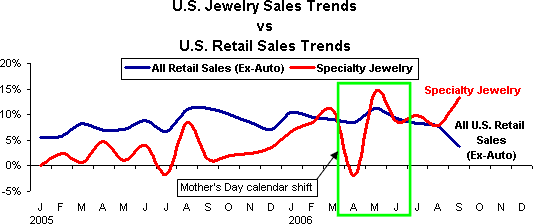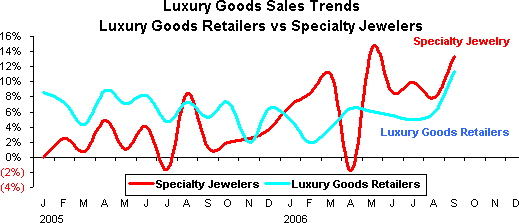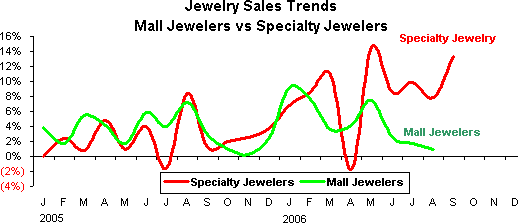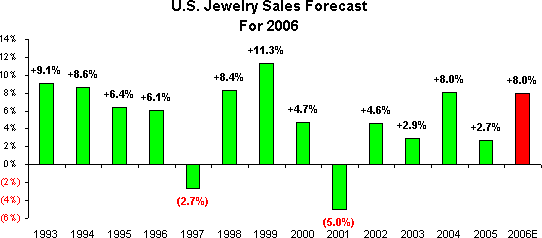IDEX Online Research: September U.S. Retail Jewelry Sales Soar
November 16, 06
Americans went shopping in September. With much lower gasoline prices, consumers breathed a sigh of relief, and treated themselves with a visit to their favorite shopping mall.
In September,
Don’t be fooled by the graph below. It shows a dip in retail sales comparisons year-over-year. This dip is due entirely to a 9.3 percent plunge in gasoline station sales. Excluding that decline, core retail sales grew nearly 0.8 percent month-over-month, or in excess of 7 percent at an annualized basis. According to most forecasters, the nation is headed toward an economic slowdown, but someone apparently forgot to tell consumers.

Source: US Dept of Commerce
In part, the strength in jewelry sales is related to relatively easy comparisons with last year. Jewelry demand dipped sharply in September 2005 due to several
Luxury Sales Strong
Along with jewelry, Americans’ demand for luxury goods remains robust. Both jewelry and other luxury goods sales rose sharply in September. For luxury goods, the sales gain was the largest gain in the past two years.
The graph below compares jewelry retail sales with retail sales of luxury goods.

Source: US Dept of Commerce & ICSC
Mall Jewelry Sales Lag
Jewelry sales among mall retailers continues to lag free-standing jewelers’ sales by a substantial margin. In part, this is related to strong sales at discount retailers, most of whom have shunned expensive mall locations for free-standing stores elsewhere in suburbia.
The graph below illustrates the disparity between mall jewelry sales (through August 2006) and specialty jewelry sales (through September 2006).

Source: US Dept of Commerce & ICSC
Outlook for Retail Sales: Some Slowing Possible
Most forecasters are calling for slowing retail sales over the next few months. Early predictions for the all-important holiday selling season suggest that this year’s retail sales gain will be more moderate than last year’s robust increase.
Declining energy prices will help support retail demand, especially for retailers catering to lower income consumers. However, most prognosticators believe that the weaker housing market will gradually take a toll on consumer demand because it will reduce the growth of household wealth. Further, record debt burdens, coupled with a non-existent savings rate, will put a damper on consumer exuberance in the malls.
The good news is that the consensus outlook calls for only a slowing economy, not a recession in 2007. Job gains are continuing, even though the pace has slowed. The current low unemployment has created upward wage pressure, meaning that consumers’ paychecks are growing rapidly.
IDEX Online Research’s Proprietary Jewelry Sales Forecast Hits New Peak
Forecasts of consumer spending in late 2006 and 2007 have a negative bias. When the negatives and positives are weighed, the scale tips toward a negative outlook. But consumers clearly don’t buy those forecasts.
For jewelry, the IDEX Online Forecast Model calls for jewelry sales to rise by about 8 percent for 2006. This is the largest gain this year, and is an increase from last month’s 7 percent increase that was predicted.
Qualitatively, we think that this mathematical model is too optimistic. However, the latest spending trends from the Consumer Expenditure Survey (CES), a government survey of spending in American homes, shows that jewelry sales jumped by more than 13 percent, year-over-year in September. For most of 2006, this indicator has been showing a jewelry sales gain in the low double digit range – +10 percent-12 percent. In other words, consumers are saying that they are spending heavily on jewelry versus the same period last year.
If we believe that consumers are telling the truth (when it comes to jewelry, they have been known to overstate its value on the CES form), then it would indicate that specialty jewelers are losing market share to other retailers such as Wal-Mart and department stores such as J.C. Penney. With specialty jewelry sales up 11.3 percent in September and total jewelry sales up 13.4 percent, simple math tells us that jewelry demand among non-specialty jewelers – discounters, traditional department stores, and others – jumped by more than 15 percent. That’s possible due to easy comparisons. That’s also a subject for analysis at year-end.
Based on the most recent numbers, it would appear that jewelry sales in
Further, if these sales trends in September continue, the IDEX Online holiday sales forecast for the
The graph below summarizes the IDEX Online Research forecast for jewelry sales in the
|
|
